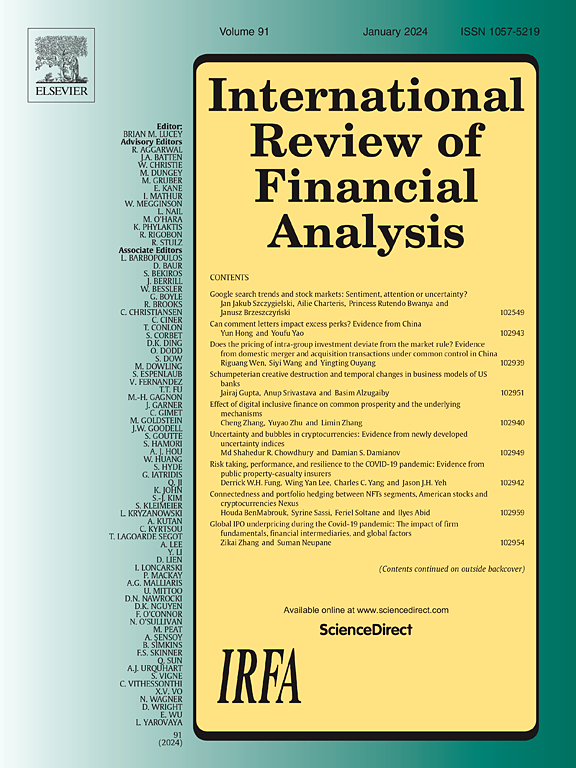How digital transformation reduces stock Price crash risk: Unpacking the roles of financing and efficiency
IF 9.8
1区 经济学
Q1 BUSINESS, FINANCE
引用次数: 0
Abstract
Although corporate digitalization's impact on productivity and innovation has been widely studied, its role in financial risk management remains underexplored. Stock price crash risk poses a serious threat to market stability, with the potential to undermine investor confidence and trigger systemic disruptions. Existing literature largely emphasizes traditional determinants of crash risk (e.g., corporate governance and accounting conservatism) while largely neglecting technological factors. This omission limits our understanding of how digital transformation might act as a safeguard against extreme market events. This study examines whether digital transformation reduces stock price crash risk through two primary mechanisms: easing financing constraints and enhancing operational efficiency. Drawing on a comprehensive dataset of Chinese A-share listed firms from 2011 to 2022, we employ multiple regression techniques (i.e., instrumental variable (IV) analysis, propensity score matching (PSM), and Heckman two-stage models) to address potential endogeneity concerns. The empirical results indicate that digital transformation significantly lowers crash risk by improving information transparency, reinforcing governance structures, and optimizing resource allocation. Mediation analysis confirms that digital adoption mitigates crash risk by reducing financing constraints and enhancing operational efficiency. Furthermore, heterogeneity analyses show that these risk-mitigating effects vary by ownership type, industry, and stage in the firm lifecycle, being more pronounced in nonstate-owned enterprises, technology-intensive sectors, and firms in the growth and maturity phases. These findings contribute to a deeper understanding of the role of digitalization in corporate risk management and offer valuable guidance for firms, investors, and policymakers seeking to strengthen financial resilience through strategic digital initiatives.
数字化转型如何降低股价崩盘风险:解开融资和效率的角色
尽管企业数字化对生产力和创新的影响已被广泛研究,但其在财务风险管理中的作用仍未得到充分探讨。股价崩盘风险对市场稳定构成严重威胁,有可能削弱投资者信心并引发系统性混乱。现有文献在很大程度上强调了崩溃风险的传统决定因素(例如,公司治理和会计保守主义),而在很大程度上忽视了技术因素。这种遗漏限制了我们对数字化转型如何防范极端市场事件的理解。本研究考察了数字化转型是否通过缓解融资约束和提高运营效率两种主要机制来降低股价崩盘风险。利用2011年至2022年中国a股上市公司的综合数据集,我们采用多元回归技术(即工具变量(IV)分析、倾向得分匹配(PSM)和Heckman两阶段模型)来解决潜在的内生性问题。实证结果表明,数字化转型通过提高信息透明度、强化治理结构和优化资源配置显著降低了崩溃风险。中介分析证实,采用数字技术可以通过减少融资限制和提高运营效率来减轻崩溃风险。此外,异质性分析表明,这些风险缓解效应因所有权类型、行业和企业生命周期阶段而异,在非国有企业、技术密集型行业以及处于成长期和成熟期的企业中更为明显。这些发现有助于更深入地理解数字化在企业风险管理中的作用,并为寻求通过战略性数字化举措增强财务弹性的公司、投资者和政策制定者提供有价值的指导。
本文章由计算机程序翻译,如有差异,请以英文原文为准。
求助全文
约1分钟内获得全文
求助全文
来源期刊

International Review of Financial Analysis
BUSINESS, FINANCE-
CiteScore
10.30
自引率
9.80%
发文量
366
期刊介绍:
The International Review of Financial Analysis (IRFA) is an impartial refereed journal designed to serve as a platform for high-quality financial research. It welcomes a diverse range of financial research topics and maintains an unbiased selection process. While not limited to U.S.-centric subjects, IRFA, as its title suggests, is open to valuable research contributions from around the world.
 求助内容:
求助内容: 应助结果提醒方式:
应助结果提醒方式:


